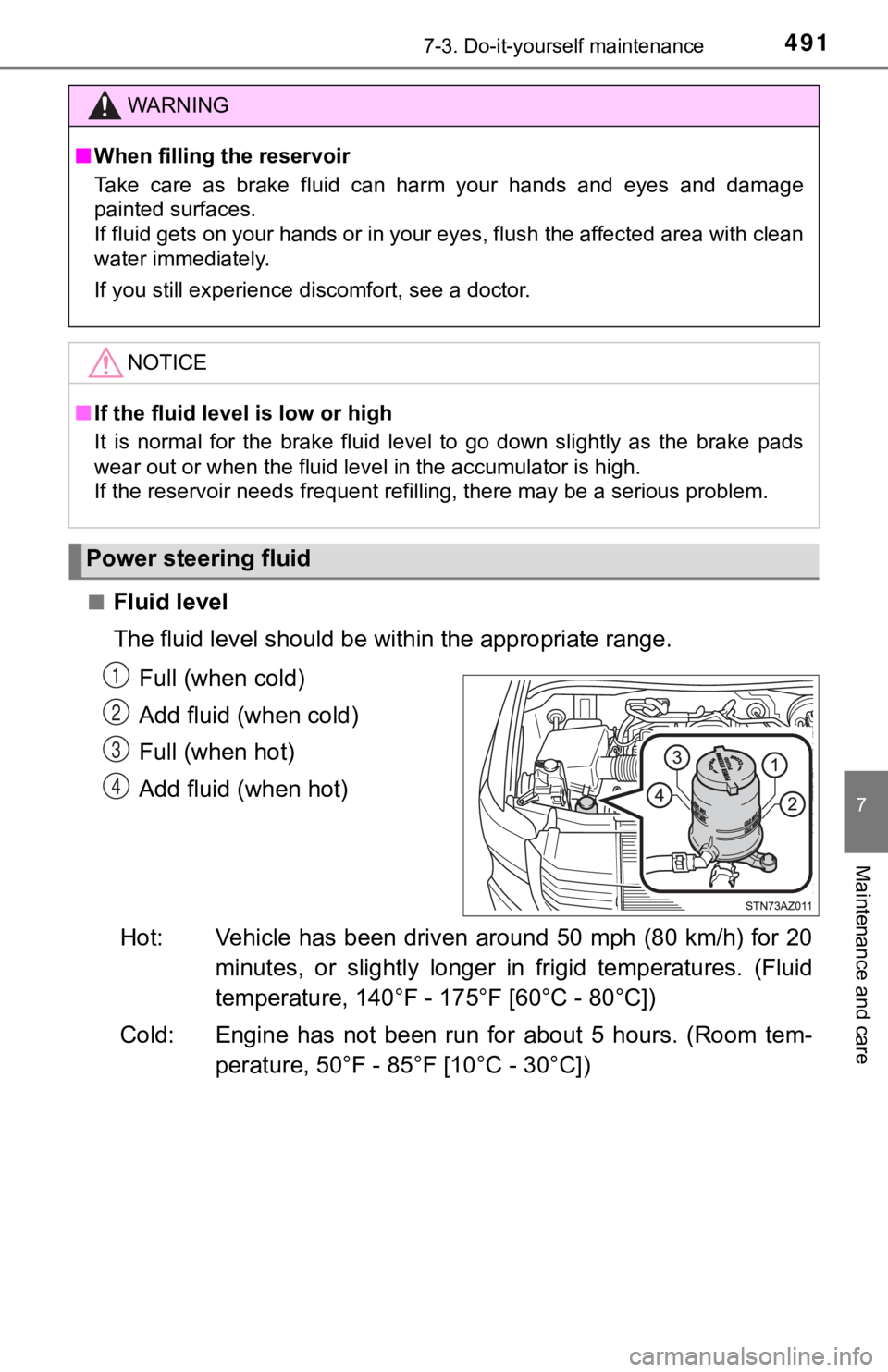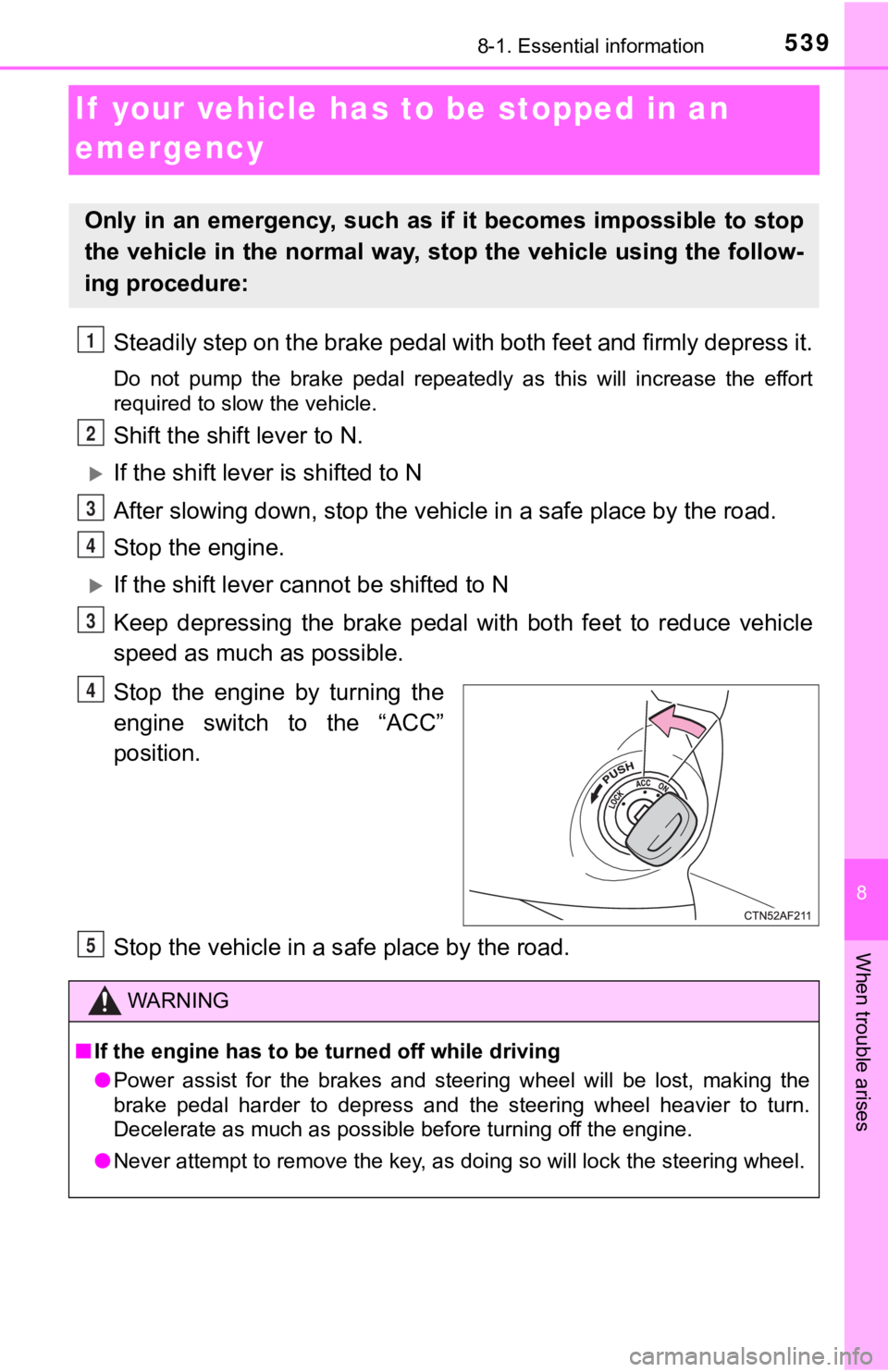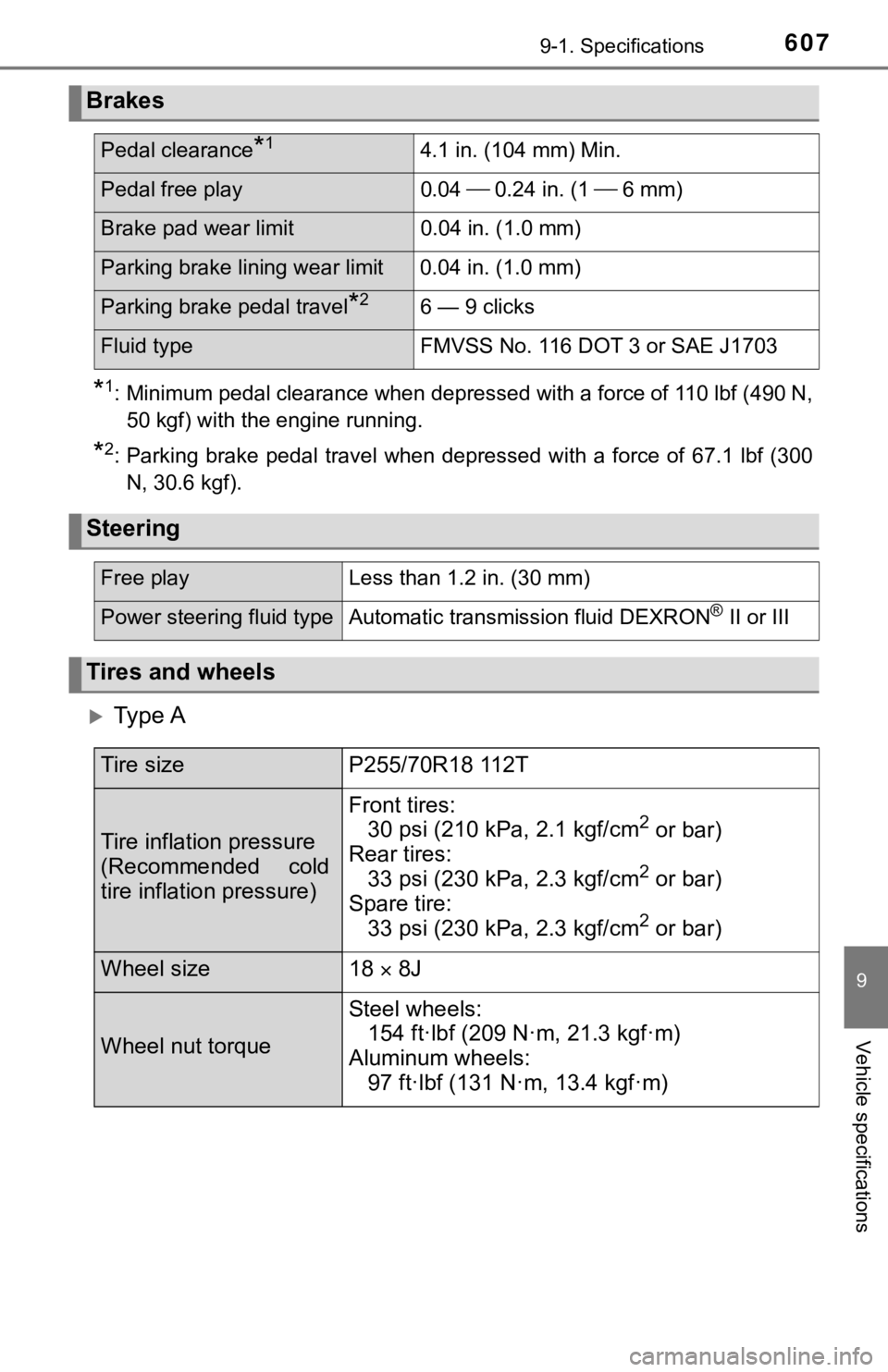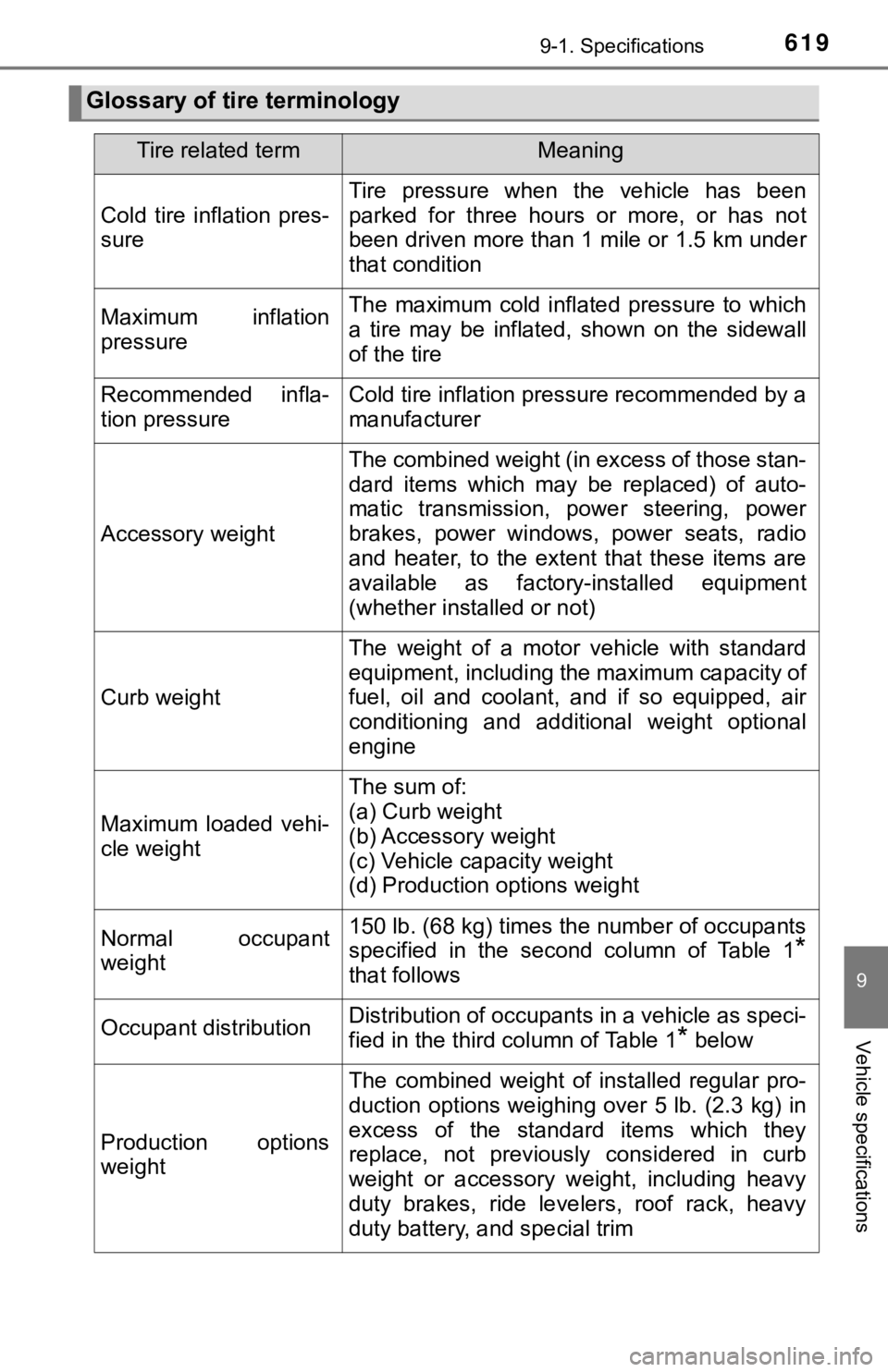Page 485 of 672
4857-3. Do-it-yourself maintenance
7
Maintenance and care
Engine compartment
Washer fluid tank (P. 494)
Engine oil level dipstick ( P. 486)
Engine coolant reservoir ( P. 488)
Engine oil filler cap ( P. 487)
Brake fluid reservoir ( P. 490) Fuse box (
P. 518)
Battery ( P. 492)
Radiator ( P. 490)
Cooling fan
Condenser ( P. 490)
Power steering fluid reservoir ( P. 491)1
2
3
4
5
6
7
8
9
10
11
Page 491 of 672

4917-3. Do-it-yourself maintenance
7
Maintenance and care
■Fluid level
The fluid level should be within the appropriate range.Full (when cold)
Add fluid (when cold)
Full (when hot)
Add fluid (when hot)
Hot: Vehicle has been driven around 50 mph (80 km/h) for 20 minutes, or slightly longer in frigid temperatures. (Fluid
temperature, 140°F - 175°F [60°C - 80°C])
Cold: Engine has not been run for about 5 hours. (Room tem- perature, 50°F - 85°F [10°C - 30°C])
WARNING
■When filling the reservoir
Take care as brake fluid can harm your hands and eyes and damag e
painted surfaces.
If fluid gets on your hands or in your eyes, flush the affected area with clean
water immediately.
If you still experience discomfort, see a doctor.
NOTICE
■ If the fluid level is low or high
It is normal for the brake fluid level to go down slightly as t he brake pads
wear out or when the fluid level in the accumulator is high.
If the reservoir needs frequent refilling, there may be a serio us problem.
Power steering fluid
1
2
3
4
Page 492 of 672
4927-3. Do-it-yourself maintenance
■Checking the fluid level
Make sure to check the fluid type and prepare the necessary items.
Clean all dirt off the reservoir.
Remove the cap by turni ng it counterclockwise.
Wipe the dipstick clean.
Reinstall the cap and remove it again.
Check the fluid level.
Check the battery as follows:
■Battery exterior
Make sure that the battery terminals are not corroded and that
there are no loose connections, cracks, or loose clamps.
Terminals
Hold-down clamp
Fluid type Automatic transmission fluid DEXRON® II or III
Items Rag or paper, clean funnel (only for adding fluid)
WARNING
■Checking the fluid level
Take care, as the reservoir may be hot.
NOTICE
■When adding fluid
Avoid overfilling, or the power steering may be damaged.
■ After replacing the reservoir cap
Check the steering box case, vane pump and hose connections for leaks or
damage.
Battery
1
2
3
4
5
1
2
Page 539 of 672

539
8
When trouble arises
8-1. Essential information
If your vehicle has to be stopped in an
emergency
Steadily step on the brake pedal with both feet and firmly depress it.
Do not pump the brake pedal repeatedly as this will increase th e effort
required to slow the vehicle.
Shift the shift lever to N.
If the shift lever is shifted to N
After slowing down, stop the vehi cle in a safe place by the road.
Stop the engine.
If the shift lever cann ot be shifted to N
Keep depressing the brake pedal with both feet to reduce vehicl e
speed as much as possible.
Stop the engine by turning the
engine switch to the “ACC”
position.
Stop the vehicle in a s afe place by the road.
Only in an emergency, such as if it becomes impossible to stop
the vehicle in the normal way, st op the vehicle using the follow-
ing procedure:
1
2
3
4
3
4
WARNING
■ If the engine has to be turned off while driving
● Power assist for the brakes and steering wheel will be lost, ma king the
brake pedal harder to depress and the steering wheel heavier to turn.
Decelerate as much as possible before turning off the engine.
● Never attempt to remove the key, as doing so will lock the stee ring wheel.
5
Page 607 of 672

6079-1. Specifications
9
Vehicle specifications
*1: Minimum pedal clearance when depressed with a force of 110 lbf (490 N,
50 kgf) with the engine running.
*2: Parking brake pedal travel when depressed with a force of 67.1 lbf (300 N, 30.6 kgf).
Ty p e A
Brakes
Pedal clearance*14.1 in. (104 mm) Min.
Pedal free play 0.04 0.24 in. (1 6 mm)
Brake pad wear limit 0.04 in. (1.0 mm)
Parking brake lining wear limit 0.04 in. (1.0 mm)
Parking brake pedal travel*26 — 9 clicks
Fluid typeFMVSS No. 116 DOT 3 or SAE J1703
Steering
Free playLess than 1.2 in. (30 mm)
Power steering fluid typeAutomatic transmission fluid DEXRON® II or III
Tires and wheels
Tire sizeP255/70R18 112T
Tire inflation pressure
(Recommended cold
tire inflation pressure)
Front tires:
30 psi (210 kPa, 2.1 kgf/cm2 or bar)
Rear tires: 33 psi (230 kPa, 2.3 kgf/cm
2 or bar)
Spare tire: 33 psi (230 kPa, 2.3 kgf/cm
2 or bar)
Wheel size18 8J
Wheel nut torque
Steel wheels:
154 ft·lbf (209 N·m, 21.3 kgf·m)
Aluminum wheels: 97 ft·lbf (131 N·m, 13.4 kgf·m)
Page 619 of 672

6199-1. Specifications
9
Vehicle specifications
Glossary of tire terminology
Tire related termMeaning
Cold tire inflation pres-
sure
Tire pressure when the vehicle has been
parked for three hours or more, or has not
been driven more than 1 mile or 1.5 km under
that condition
Maximum inflation
pressureThe maximum cold inflated pressure to which
a tire may be inflated, shown on the sidewall
of the tire
Recommended infla-
tion pressureCold tire inflation pressure recommended by a
manufacturer
Accessory weight
The combined weight (in excess of those stan-
dard items which may be replaced) of auto-
matic transmission, power steering, power
brakes, power windows, power seats, radio
and heater, to the extent that these items are
available as factory-installed equipment
(whether installed or not)
Curb weight
The weight of a motor vehicle with standard
equipment, including the maximum capacity of
fuel, oil and coolant, and if so equipped, air
conditioning and additional weight optional
engine
Maximum loaded vehi-
cle weight
The sum of:
(a) Curb weight
(b) Accessory weight
(c) Vehicle capacity weight
(d) Production options weight
Normal occupant
weight150 lb. (68 kg) times the number of occupants
specified in the second column of Table 1
*
that follows
Occupant distributionDistribution of occupants in a vehicle as speci-
fied in the third column of Table 1
* below
Production options
weight
The combined weight of installed regular pro-
duction options weighing over 5 lb. (2.3 kg) in
excess of the standard items which they
replace, not previously considered in curb
weight or accessory weight, including heavy
duty brakes, ride levelers, roof rack, heavy
duty battery, and special trim
Page 655 of 672

655What to do if... (Troubleshooting)
●It is locked to prevent theft of the vehicle if the key is removed from the
engine switch. ( P. 196)
●Is the window lock switch pressed?
The power window except for the one at the driver’s seat cannot be oper-
ated if the window lock switch is pressed. ( P. 147)
●The seat belt reminder light is flashing
Are the driver and the front passenger wearing the seat belts? (P. 548)
●The parking brake indicator is on
Is the parking brake released? ( P. 205)
Depending on the situation, other types of warning buzzer may also sound.
( P. 547, 555)
●Did anyone inside the vehicle open a door during setting the al arm?
The sensor detects it and the alarm sounds. ( P. 85)
To stop the alarm, turn the engine switch to the “ACC” or “ON” position, or
start the engine.
●When a warning light turns on or a warning message is displayed , refer to
P. 547, 555.
The steering wheel cannot be turned after the engine is
stopped
The windows do not open or close by operating the power
window switches
A warning buzzer sounds during driving
An alarm is activated and the horn sounds
A warning light turns on or a warning message is displayed
Page 665 of 672

665Alphabetical index
Parking assist sensors (intuitive parking assist) ....... 270
Parking brake ........................... 205 Operation .............................. 205
Parking brake engaged
warning buzzer ................... 547
Parking brake engaged
warning message ............... 557
Parking lights ........................... 206 Light switch ........................... 206
Replacing light bulbs..... 527, 534
Wattage ................................ 609
PCS
(Pre-Collision System) .......... 231 Pre-collision brake assist ...... 232
Pre-collision braking ............. 232
PCS warning ......................... 232
Warning light ......................... 550
Warning message ................. 555
Pen holder ................................ 439
Personal lights ......................... 430 Light switch ........................... 430
Wattage ................................ 609
Power back window ................ 151
Power easy access system .... 128
Power outlets ........................... 452
Power steering fluid ................ 491
Power windows........................ 147 Jam protection function......... 148
Operation .............................. 147
Window lock switch............... 147
Pre-Collision System (PCS) ...................................... 231 Radar cruise control
(dynamic radar
cruise control) ....................... 252
Radiator .................................... 490
Radio ........................................ 340
Rear personal lights ................ 430
Rear seat
Adjustment precautions ........ 127
Child seats/child restraint system installation . ............... 60
Cleaning ............................... 473
Head restraints ..................... 132
Raising the bottom cushion ............................... 126
Rear side marker lights........... 206 Light switch ........................... 206
Replacing light bulbs ............ 532
Wattage ................................ 609
Rear step bumper .................... 122
Rear turn signal lights ............ 204
Replacing light bulbs ............ 532
Turn signal lever ................... 204
Wattage ................................ 609
Rear view mirror Inside rear view mirror .......... 139
Outside rear view mirrors ..... 142
Rear view monitor system ...... 277
Refueling .................................. 220 Capacity................................ 601
Fuel types ............................. 601
Opening the fuel tank cap..... 220
PR